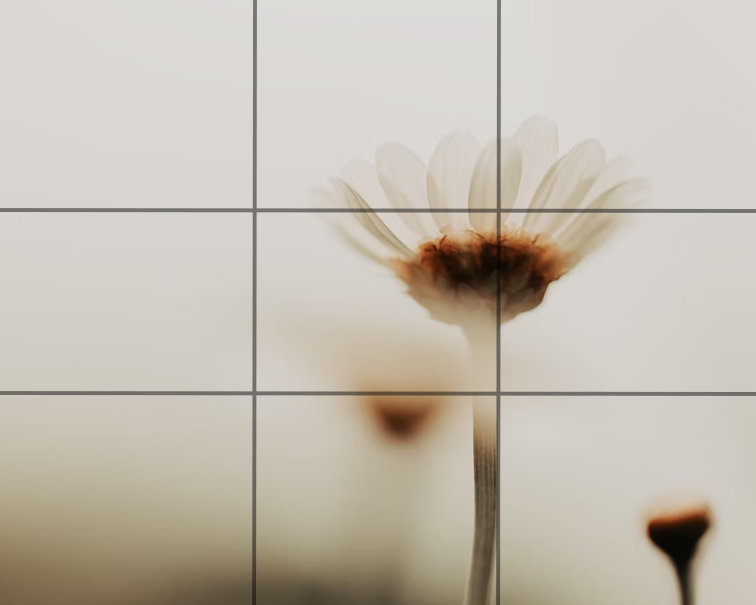Rule of Thirds Explained for Beginner Photographers
Michael • updated January 1, 2023 • 3 min read
Michael • updated January 1, 2023 • 3 min read

Are you tired of taking bland, uninspiring photos that just don’t quite cut it? Want to up your photography game and create dynamic, eye-catching compositions?
Look no further! The Rule of Thirds is here to save the day. This simple yet powerful technique can take your photos from “meh” to “wow” in no time. So grab your camera (or phone, no judgment here) and let’s get started!
Content
Alright, let’s talk about the Rule of Thirds. It’s a basic photography technique that can help you take better pictures by creating more balanced and dynamic compositions. Here’s how it works:
Imagine that your frame is divided into nine equal parts using two horizontal lines and two vertical lines. This creates a grid that looks like this:

The idea is to place your subject along one of these lines or at one of the intersections of the grid. This creates a more interesting and balanced composition, rather than just putting your subject in the middle of the frame.
It’s like the photography equivalent of “don’t put all your eggs in one basket.”
If you like to read more about how to place subjects, we have a guide explaining the golden ratio in photography.

But the Rule of Thirds isn’t just about balance. It can also be used to add tension or movement to a photo. For example, if you put your subject along one of the lines that leads out of the frame, it can look like your subject is moving or going somewhere.
Or, if you put your subject at one of the intersections, it can create a sense of excitement or drama. It’s like the photography equivalent of “drama is good, as long as it’s not in real life.”
Read also about how diagonal lines can improve your photos.
The Rule of Thirds isn’t just a cool photography trick, it also has some real benefits that can take your compositions to the next level. Here are a few reasons why you should consider using the Rule of Thirds in your photography:
Creates balance and harmony in the frame: By placing your subject along the lines or at the intersections of the grid, you can create a more balanced composition that is pleasing to the eye. It’s like the photography equivalent of “all’s well that ends well.”
Helps to draw the viewer’s eye to the subject: By using the Rule of Thirds, you can create a natural flow that guides the viewer’s eye to the main subject of your photo. It’s like the photography equivalent of “follow the yellow brick road.”
Can add tension or energy to a composition: As mentioned before, the Rule of Thirds can also be used to add tension or movement to a photo.
By placing your subject along one of the lines that leads out of the frame, you can create a sense of direction. Or, by placing your subject at one of the intersections, you can create a sense of drama. It’s like the photography equivalent of “drama is good, as long as it’s not in real life.”

Now that you know all about the Rule of Thirds, it’s time to put it into practice! Here are a few tips to help you get started:
Practice makes perfect: The more you look for opportunities to use the Rule of Thirds in your compositions, the better you’ll get at it. So don’t be afraid to snap plenty of photos and experiment with different placements of your subject. It’s like the photography equivalent of “fake it till you make it.”
Use the grid on your camera or in editing software: Many cameras and editing programs have a grid function that you can use to help you visualize the Rule of Thirds.
This can be especially helpful when you’re just starting out. It’s like the photography equivalent of “a little help never hurt anyone.”
Don’t be afraid to break the rule: While the Rule of Thirds is a great starting point, it’s not a hard and fast rule. If you feel like breaking the rule will create a stronger composition, then go for it! The most important thing is to create images that you love and that speak to you.
It’s like the photography equivalent of “rules are meant to be broken, as long as you’re not breaking the law.”

Remember, the more you practice, the better you’ll get. So don’t be discouraged if you don’t get it right away. Just keep at it and have fun! The most important thing is to create images that you love and that speak to you.

Landscape photo, horizon upper third, @naii
The Rule of Thirds is a valuable technique for any photographer, beginner or expert. By dividing the frame into nine equal parts and placing your subject along the lines or at the intersections of the grid, you can create balanced and dynamic compositions that really stand out.
Remember, the Rule of Thirds is not a hard and fast rule, so don’t be afraid to experiment and try different placements of your subject. The most important thing is to create images that you love and that speak to you.
So go ahead, give the Rule of Thirds a try and see how it can improve your photography skills. Happy shooting!
Beginner Photography Sections
» How to start Photography
» DSLR or System Camera
» Aperture
» Shutter Speed
» Camera ISO
» Exposure
» White Balance
» Histogram
» Camera Modes
» Camera Focus Modes
» Sharp Images
» Composition – Rule of Thirds
» Photography Mistakes to avoid
» Important Tips for Beginners
Related Articles
Beginner Photography
Beginner Photography
Beginner Photography
Beginner Photography
Your thoughts and questions